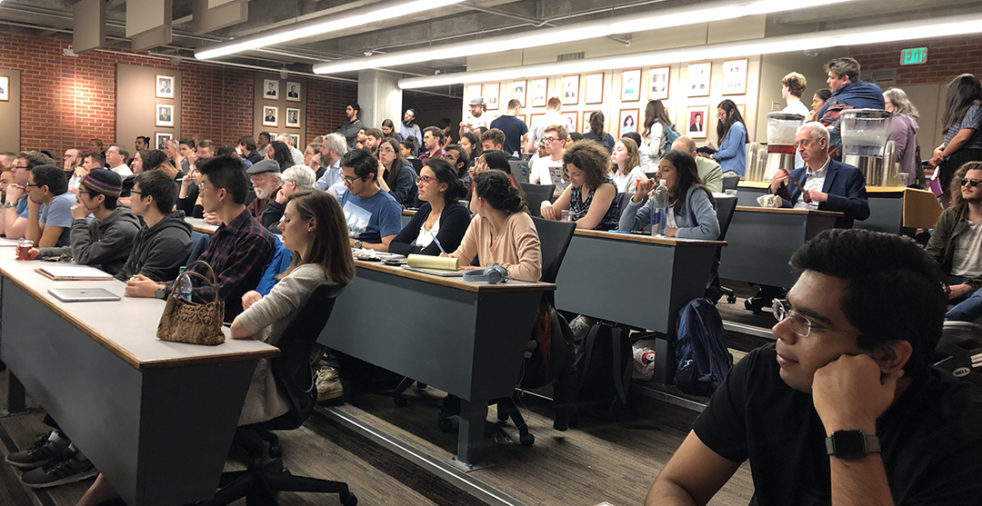Early this month and in late March saw two summits which focused on the earth and planetary sciences. From Thursday, March 28 to Friday, March 29, Georgia Tech Astrobiology and the Explorigins Group hosted the Exploration and Origins Colloquium, a conference intended to showcase efforts in developing space exploration technology and studying the origins of life. The OceanVisions2019 summit — which was held from Monday, April 1 to Thursday, April 4 — presented on the current status of ocean science, which includes the study of ocean systems and their interactions, as well as mitigation and sustainability efforts.
This year’s Astrobiology conference, which is the event’s second iteration following the 2018 colloquium, brought in renowned researchers and faculty. The first day began with a lecture by Dr. Kevin Hand — deputy project scientist at the Jet Propulsion Laboratory (JPL). Hand explained how it is determined if a planetary body is “suitable” for life. Europa and Enceladus — two of the respective moons of Jupiter and Saturn — are promising because they may harbor interior oceans that could possibly be home to life; this has thus sparked efforts to explore the moons’ surfaces.
Friday’s program consisted of two segments — the morning showcased technologies being developed for space exploration, while the afternoon presented on the study of the chemical and biological origins of life. Plenary lectures were delivered by researchers including Paul Steffes — professor within the School of Electrical and Computer Engineering — who spoke on how radio waves can be used to determine planetary composition and identify intelligent life. Sara Walker — professor and astrobiologist at the School of Earth and Space Exploration at Arizona State University — lectured on the common patterns and “laws” of life; after all, the ability to identify life’s origins on other planetary bodies is much enabled by research conducted on past and present life on Earth.
Other talks included those by Zach Siebars and Justin Lawrence, which detailed the development of new spacesuit materials and submersibles to explore interior oceans. Adrian Ildefonso and William Jun talks focused on developing electronics to function in radiation environments and creating methods to determine rover location on the surfaces of planetary bodies.
The colloquium was organized with the hope of consolidating the interdisciplinary fields involved in the search for life, as well as exposing such topics and research to young career scientists and students.
Dr. Micah Schaible—postdoctoral fellow in the School of Chemistry and Biochemistry and an organizer of the colloquium—noted that there are many technical obstacles to be overcome in travelling to and operating on planetary bodies. Schaible’s own research focuses on studying the effects of ionizing radiation on dust particles, which can pose challenges for astronaut-led space exploration.
“On the surfaces of these airless bodies, you have this fine powdered dust called a ‘regolith,’” said Schaible. “Those dust grains, during the Apollo era, were seen to stick all over the astronauts … where we are really pushing it into is how these dust grains [will] affect astronauts.”
Schaible works with REVEALS, a multidisciplinary team that partners with NASA in its Solar System Exploration Research Virtual Institute (SSERVI) program.
“REVEALS is a bridging institution looking partly at science questions we can answer and also forwarding exploration technology,” said Schaible. “The idea of SSERVI is to be this loose-knit network in which everybody is working on not totally different, but not totally the same, research.”
Dr. George Zaharescu—postdoctoral fellow at the Department of Earth and Atmospheric Sciences and an organizer of the 2018 and 2019 Astrobiology colloquiums—works to understand the link between prebiotic chemistry and the earliest living organisms. Zaharescu noted that studying the origins of life involve both chemical and biological perspectives; in his research, Zaharescu studies chemical biosignatures and the connection between the biosphere and its abiotic components.
“The easiest way to find life, to understand what life is, is actually to look at Earth,” said Zaharescu.
The OceanVisions summit was jointly organized by researchers at Georgia Tech, Stanford University, Scripps Institute of Oceanography, and the Smithsonian Institute. Among the conference’s keynote speakers include academic faculty, researchers, and representatives from environmental organizations and nonprofits.
The first day featured researchers specializing in coastal climate change—these included Dr. A. R. Siders, Environmental Fellow at the Harvard University Center for the Environment; and Emily Pidgeon, senior director of Conservation International’s Strategic Marine Initiatives. Among the talks included studies of specific geographic regions; observations have been recorded of adaptations made to address saltwater intrusion in the Philippines and Vietnam, as well as the construction of communities resilient to storm surges in Bangladesh.
Tuesday’s keynotes delved into the building of resilient coastal ecosystems, including those of coral reefs.
The afternoon sessions focused on the effects of biogeochemical processes—like acidification, deoxygenation, and heavy metal accumulation—on ocean ecology. The evening featured an Ocean Visions reception at the Georgia Aquarium, which intended to teach participants how to invest in innovations that can lead to ocean solutions.
Wednesday’s program elaborated on the spatial planning of aquaculture as a means of efficiently utilizing marine resources. After all, many present-day coastal countries operate off a “blue economy,” which operates through marine activities like fishing and shipping. The day concluded with a poster session at the Environmental Science & Technology building.
Thursday concluded with talks on information and quantity-driven models, which can be used to create predictions regarding human and climate impacts on ocean ecosystems.
Ultimately, Georgia Tech has continued to expand its presence within the field of Astrobiology, including by establishing the Oceans Across Space and Time (OAST), a NASA-funded project.
Students further interested in astrobiology may consider joining the Explorigins Group—a discussion group comprised of students and early career scientists focused on the topics of life’s origins and the search for life both within and beyond our solar system.
